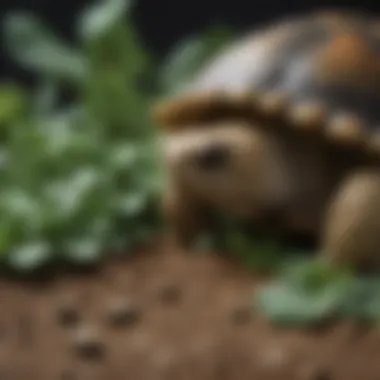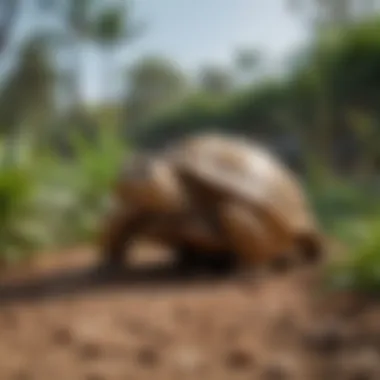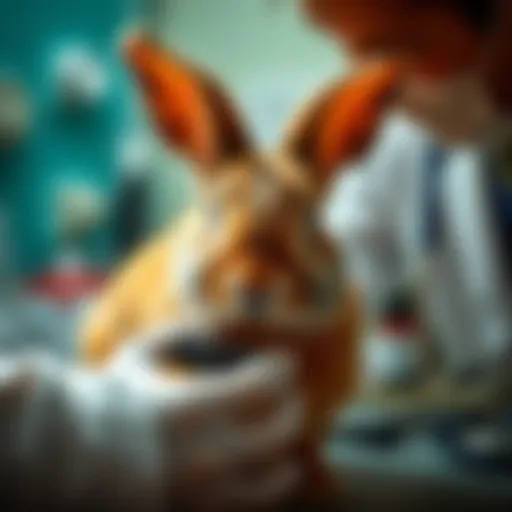Essential Guide to Sulcata Tortoise Nutrition Needs


Intro
Understanding the diet of a sulcata tortoise is vital for pet owners. This large tortoise, also known as the African spurred tortoise, has distinct dietary needs that ensure its health and longevity. Proper nutrition is not merely about feeding; it is about grasping the full scope of what these reptiles require for their well-being. Sulcata tortoises thrive on a diet rich in certain types of vegetation, along with specific supplements to meet their nutritional needs.
Many misconceptions surround the dietary practices for sulcata tortoises. Some people think any leafy green is suitable, while others may not realize the importance of fiber in a tortoise's diet. This guide aims to clarify these issues, providing pet owners with an enriched understanding of how to cater to their sulcata tortoise’s nutritional requirements.
Understanding Your Pet
Pet Behavior Basics
Sulcata tortoises exhibit unique behaviors that can be observed when they are comfortable in their environment. They tend to be active during the day, searching for food and basking in the sun. Understanding your pet's behavior helps in creating a suitable habitat.
Common Breed Characteristics
The sulcata tortoise is among the largest tortoise species, capable of growing up to 30 inches long. These tortoises have a strong, domed shell with a coloration that ranges from brown to tan. Their physical stature can sometimes lead to misconceptions about their agility; however, these tortoises are surprisingly quick when motivated.
Species-Specific Needs
Every species has its dietary and care requirements. For sulcata tortoises, their native habitat in Africa consists of arid regions with abundant grasses and shrubs. Thus, their diet should mimic this by focusing on high-fiber grasses and avoiding high-protein and high-fat foods, which can lead to health problems.
Pet Care and Maintenance
Feeding Guidelines
Feeding guidelines for sulcata tortoises include:
- A diet predominantly consisting of grasses and hay.
- Fresh, non-toxic weeds and leafy greens must be offered in moderation.
- Calcium and vitamin D3 supplements are critical, especially for juvenile tortoises to ensure proper shell growth and development.
Grooming Essentials
Grooming is not as intensive as with some other pets, but regular checks are important. Scrutinize the shell for any signs of infection or injury. Shell maintenance can involve gentle brushing to remove excess dirt but should be done carefully to avoid damaging the shell.
Hygiene Practices
Hygiene practices can influence health. Ensure that the habitat remains clean to prevent the buildup of waste, which can cause diseases. Regular substrate changes and habitat cleaning are essential.
Health and Wellness
Routine Vet Check-ups
Routine veterinary check-ups can catch potential health issues early. It’s advisable to find a veterinarian experienced with reptiles, as they can guide the specific needs of sulcata tortoises.
Vaccination Needs
Unlike dogs or cats, tortoises do not require vaccinations. However, they do need regular check-ups to monitor their health status, especially in the case of those in a multi-species environment.
Recognizing Signs of Illness
Being observant can allow for the early detection of illness. If a sulcata tortoise displays symptoms such as a lack of appetite, lethargy, or unusual shell changes, it’s crucial to consult a vet promptly.
Enrichment and Activities
Indoor vs.
Outdoor Activities
Sulcata tortoises are outdoor creatures. Their habitat should allow for plenty of space to roam and explore. However, they can benefit from structured indoor activities on colder days.
Interactive Toys and Games
While tortoises do not play with toys in the traditional sense, exploring new textures and places can stimulate their curiosity. Hiding food within their environment can also encourage natural foraging behavior.
Socialization Opportunities
Socialization is important. While sulcata tortoises can thrive alone, interaction with their owners can create a bond and enrich their experiences. Always supervise interactions with other pets to prevent stress or harm.
Providing proper nutrition and care for your sulcata tortoise is not just beneficial for the animal; it is also an enriching experience for the owner.


Understanding Sulcata Tortoises
Understanding the sulcata tortoise is critical for anyone who wishes to care for this remarkable species. Sulcata tortoises, also known as African spurred tortoises, can grow remarkably large and live many years. Thus, their care demands understanding their natural behaviors, habitats, and dietary needs.
Natural Habitat and Diet
Sulcata tortoises are native to the dry regions of North Africa. They primarily thrive in grasslands and savannahs where they can access plenty of sunlight and grassy vegetation. These habitats are characterized by hot temperatures and limited rainfall, which influence the tortoise's dietary needs significantly. In the wild, their diet is composed mostly of grasses, herbs, and a few varieties of flowering plants.
Key elements of their natural habitat include:
- Abundant sunlight for basking.
- Access to various herbaceous plants and grasses.
- Natural burrows to regulate temperature in extreme conditions.
These environmental factors shape not only their diet but also their overall health. Understanding these elements helps pet owners replicate suitable environments and dietary options.
Importance of Nutrition
The nutritional needs of sulcata tortoises play a crucial role in their health and longevity. With a proper diet, these tortoises can develop strong bones and shells, which are vital for their survival. A balanced diet rich in fiber is essential because, lacking it, sulcata tortoises may face health issues like obesity, shell deformities, or digestive problems.
Key nutritional aspects include:
- High fiber content: Supports digestion and prevents health issues.
- Calcium and vitamins: Necessary for shell growth and overall vitality.
- Water intake: Essential to maintain hydration and prevent metabolic disorders.
Providing a proper diet not only supports the physical health of the sulcata tortoise but also enhances its quality of life.
Pet owners must recognize the crucial link between proper nutrition and the well-being of their tortoises. By understanding these nutritional needs and how they relate to the tortoise's natural habitat, owners can better care for their reptiles.
Main Components of Sulcata Diet
Understanding the main components of the sulcata tortoise's diet is critical for ensuring their health. These components are tied deeply to their natural habitat and behaviors. Proper nutrition impacts growth, reproductive status, and overall longevity. In captivity, it is necessary to replicate these natural dietary habits as closely as possible. A balanced diet enriches their living experience.
Herbaceous Plants
Types of Suitable Vegetation
Sulcata tortoises thrive on a variety of herbaceous plants found in their natural environments. Suitable vegetation includes varieties like dandelions, clover, and various leafy greens. These plants are characterized by their high fiber content and low protein levels, aligning closely with the tortoise's natural intake.
The inclusion of these plants ensures that sullcata tortoises receive a nutritious and varied diet. They provide essential nutrients while preventing health issues caused by high-protein diets. However, it is necessary to ensure that any plants offered have not been exposed to pesticides or harmful chemicals.
Nutritional Benefits
Herbaceous plants offer significant nutritional advantages. They are rich in vitamins and minerals that support the overall well-being of sulcata tortoises. For example, dandelions are packed with calcium, which is vital for shell health and growth. High-fiber content aids in digestion.
The diverse range of nutrients found in these plants also helps prevent obesity and related health complications. However, tortoises can be picky eaters, so providing a range of herbaceous plants can encourage a varied diet.
Grasses
Best Grass Varieties
Grasses are another important part of the sulcata tortoise diet. They typically consume varieties like timothy grass, Bermuda grass, and hay. These grasses are advantageous due to their high fibers and low protein content that aligns well with the digestive system of tortoises. Fiber assists in maintaining a healthy gut, promoting the necessary flora for digestion.
When choosing grass types, ensure they are free from contaminants and safe for the tortoise to consume. Grass plays a crucial role in mimicking their natural diet more closely.
Grassland Habitat Recreation
Creating a grassland habitat for sulcata tortoises enhances their nutritional intake and well-being. A well-planned grassland can encourage natural foraging behavior, which is essential for their mental stimulation. It also enriches their diet as they can graze on various grass types.
An ideal setup could include a large outdoor space where sulcata tortoises can roam freely. This approach mimics their natural behavior and is beneficial in maintaining a balanced diet. Ensuring a sufficient area will also help with exercise, promoting overall health.
Flowers and Weeds
Edible Flower Options
Incorporating edible flowers can add variety and nutritional benefits to a sulcata's diet. Options like hibiscus, nasturtium, and calendula are safe and nutritious. These flowers are often rich in vitamins and can enhance the diet enrihcing both aesthetics and nutrition.
Edible flowers not only serve as delicacies for sulcata tortoises but also provide hydration and additional vitamins. They can be grown in a home garden, offering a continuous supply of nutrients.
Nutritional Value of Weeds
Contrary to common belief, many weeds serve as excellent food options for sulcata tortoises. Weeds like chickweed, plantain, and purslane are often overlooked yet rich in nutritional value. Offering these weeds can be beneficial as they contain a variety of vitamins and minerals that support vitality.


Including weeds ensures tortoises have access to a natural and diverse diet. However, caution should be taken to identify species correctly and avoid harmful varieties. Ensuring that the weeds have not been treated with chemicals is essential for their safety.
Ensuring a balanced diet not only meets the nutritional needs of sulcata tortoises but also enriches their overall living experience.
Supplementing the Diet
Supplementing the diet of sulcata tortoises is crucial for their overall health and well-being. These tortoises are herbivores, requiring a diet rich in calcium and vitamins to thrive. While a varied diet of grasses and plants provides some nutrients, supplementation ensures that they receive adequate amounts of essential elements. This section discusses the importance of calcium and vitamins, as well as the need to avoid toxic plants, to promote better health for these remarkable reptiles.
Calcium and Vitamins
Importance of Calcium
Calcium plays a vital role in the health of sulcata tortoises. It is necessary for bone development and strength, as well as for proper muscle function. An inadequate calcium intake can lead to metabolic bone disease, which is a severe disorder that can cause deformities and weakness.
Sulcata tortoises need calcium to maintain strong shells and healthy limbs. It is often best supplied through natural sources like leafy greens and legumes, but many owners find they need to add supplemental calcium to their tortoises' diet. This is especially important for younger tortoises that are still growing.
An important feature of calcium is that it is more readily absorbed when paired with the right amount of vitamin D3. Therefore, ensuring your sulcata tortoise gets enough exposure to natural sunlight or provides UVB lighting in their enclosure is key, as it makes calcium supplementation even more effective.
Recommended Supplements
There are various recommended supplements for sulcata tortoises. Calcium powder is one of the most common options, and it should be dusted on their food a few times weekly. Additionally, a multivitamin supplement can help fill any nutritional gaps in their diet.
These supplements also contain vitamin A, which is essential for maintaining healthy skin and eyesight in tortoises. Owners often see improvements in their tortoises' overall vitality with consistent supplementation. However, it is crucial to follow the recommended dosages, as over-supplementation can lead to health issues.
Avoiding Toxic Plants
Common Toxic Plants
There are certain plants that sulcata tortoises should avoid entirely. Some common ones include azaleas, oleander, and yew. These plants can cause various health problems ranging from mild digestive upset to severe systemic toxicity.
Identifying these plants and keeping them away from your tortoise's habitat is essential. Being aware of such toxic plants is highly beneficial, as it helps to prevent accidental ingestion and to promote a healthier, safer living environment. A well-informed tortoise owner should thoroughly investigate the plants in their area or the plants they are sourcing for their pets.
Signs of Toxicity
Recognizing the signs of toxicity in sulcata tortoises can make a significant difference in addressing the issue promptly. Common symptoms may include lethargy, loss of appetite, swollen limbs, and difficulty breathing.
If a tortoise exhibits any of these signs after potentially ingesting toxic plants, immediate veterinary care is necessary. Being vigilant about the potential hazards in their environment equips pet owners with the tools they need to provide a safe and healthy habitat.
In summary, supplementing the diet of your sulcata tortoise with calcium and vitamins enhances their nutritional balance and addresses potential deficiencies. Understanding and avoiding toxic plants is equally important in maintaining their well-being.
Feeding Practices for Sulcata Tortoises
Feeding practices play a vital role in the overall health and well-being of sulcata tortoises. Understanding how often to feed them, what portion sizes are appropriate, and how these practices vary between juveniles and adults is essential for preventing nutritional deficiencies and ensuring a balanced diet. Proper feeding practices contribute significantly to the longevity and quality of life of these reptiles.
Frequency of Feeding
Juveniles vs.
Adults
Juvenile sulcata tortoises have different dietary needs than adults. Young tortoises are in a critical growth phase, which requires more frequent feedings. Their metabolism is generally higher, and they use nutrients faster for growth. Feeding them more often supports their rapid development.
Conversely, adult sulcata tortoises have slower metabolisms and do not require food as frequently. They can be fed less often, typically every other day or even three times a week, depending on their health and activity levels.
This distinction is crucial for maintaining their health. Overfeeding juveniles can lead to obesity, while underfeeding adults may result in malnutrition. Recognizing this difference and adjusting the feeding frequency accordingly is beneficial for the overall care of sulcata tortoises.
Recommended Feeding Schedules
Establishing a feeding schedule provides a routine for both the tortoise and its owner. A consistent schedule helps monitor the tortoise's eating habits and adjust as needed. For juvenile sulcata tortoises, a feeding schedule of daily meals is usually ideal, incorporating a variety of leafy greens and grasses.
For adults, feeding three times a week is often sufficient. This schedule can foster a healthy appetite and prevent overfeeding, which is crucial for these animals. Emphasizing the variety in their diet is also important on these scheduled days, ensuring they get all necessary nutrients.
Consistency and variety are key to a healthy feeding regimen.
Portion Sizes
Understanding Portion Control


Portion control is essential in maintaining a sulcata tortoise's diet. Knowing the right amount of food helps prevent obesity and health issues related to overfeeding. A good rule of thumb is to provide food that is roughly the size of the tortoise's shell.
Too much food can lead to waste and reasoning that they do not need to consume all presented food. When tortoises eat in excess, it creates a risk of metabolic issues. Thus, recognizing the suitable portion sizes and adjusting them based on the tortoise's size, age, and activity level is beneficial.
Adapting Portions According to Size
As sulcata tortoises grow, their portion sizes must adapt accordingly. For juveniles, smaller amounts throughout the day are better for their systems. As they become adults, the size of each meal may increase, but the total intake should still reflect their reduced feeding frequency.
Maintaining proper portion sizes during transitions is essential, as overeating can become a habit that is hard to break. Monitoring weight and health regularly ensures that feeding habits are adjusted to meet evolving dietary needs.
By understanding the different facets of feeding practices, sulcata tortoise owners can promote better health and longevity in their pets.
Common Misconceptions about Sulcata Diet
Understanding common misconceptions about sulcata tortoise nutrition is vital for pet owners. These misconceptions can lead to improper feeding practices, affecting the health and lifespan of the tortoise. Furthermore, a clear understanding can empower owners to offer a balanced diet that meets the animal's needs. This section addresses prevalent myths and clarifies the reality behind proper care, enhancing the quality of life for these unique reptiles.
Myths Surrounding Protein
A common myth about sulcata tortoises is that high protein diets are necessary for their growth and health. Some owners may think they should feed their tortoises protein-rich foods often. In reality, sulcata tortoises are primarily herbivores. Their digestive systems are designed to process high-fiber plant material, not concentrated proteins. An excess of protein can lead to health issues such as kidney damage and pyramidal shell deformities.
Protein should only be a small component of their diet. It is essential to assess the balance of protein placement, ensuring that the focus remains on fibrous vegetation. This balance is important for their long-term health prospects and overall well-being.
Water Requirements
Water intake is another area filled with myths. Some owners believe that sulcata tortoises do not need hydration. This is incorrect. While they are well adapted to dry habitats, they require constant access to clean water. Proper hydration is critical for their digestive processes and overall health. Ignoring water needs can lead to severe complications.
Hydration Importance
Hydration plays a critical role in a sulcata tortoise's life. It helps in digestion, prevents constipation, and supports physiological functions. Providing adequate water allows tortoises to hydrate through drinking as well as through their food.
One of the key characteristics of maintaining hydration is ensuring fresh water is always available. It is beneficial because it prevents health issues that arise from dehydration, such as lethargy and metabolic disorders. Keeping a shallow water dish also promotes bathing behaviors, which is important in their care.
Signs of Dehydration
Recognizing signs of dehydration is crucial for sulcata tortoise owners. Certain behaviors indicate that a tortoise is not receiving adequate moisture. These signs include lethargy, dry skin, sunken eyes, and a lack of appetite. If these symptoms appear, it is essential to address hydration as quickly as possible.
One key characteristic of dehydration signs is their subtle onset, making it essential for owners to observe their pets regularly. Catching dehydration early can prevent serious health issues. Monitoring access to water and observing behavior can be beneficial in ensuring a sulcata tortoise remains healthy and hydrated.
Maintaining a Balanced Diet
Maintaining a balanced diet is crucial for the overall health and longevity of sulcata tortoises. Their nutritional needs are specific, and proper feeding practices can significantly impact their growth and well-being. A balanced diet contributes to vital bodily functions, shell health, and energy levels. Understanding how to effectively manage their food intake minimizes the risk of obesity, which can lead to serious health issues.
Transitioning Diets
Signs of Dietary Adjustment
When transitioning a sulcata tortoise's diet, it is important to recognize the signs of dietary adjustment. These indications reflect how well the tortoise is adapting to new food types. Key characteristics include variations in eating behavior, such as increased appetite or refusal of certain foods. When a tortoise starts to show curiosity about new food items, it indicates readiness for dietary changes. This gradual adjustment can enhance nutrition and improve health.
Advantages of recognizing these signs include:
- Improved Digestive Health: A successful transition can promote better digestion.
- Enhanced Acceptance of Variety: Understanding how your tortoise responds can encourage broader dietary options in the future.
How to Transition Properly
To transition a sulcata tortoise's diet effectively, it's essential to follow a structured approach. Introduce new food gradually, mixing it with the current diet. A key characteristic of this method is maintaining consistency in feed types. Doing so can prevent digestive upsets and encourage acceptance of new items. Steps like these are beneficial because they reduce stress for the tortoise during changes.
Unique features of proper transitioning include:
- Staged Introduction: This method allows the tortoise to adapt over time.
- Observation: Monitoring changes in eating habits can ensure a smooth transition.
By properly managing dietary transitions, pet owners can contribute to the health and happiness of their sulcata tortoises.
Finale
The conclusion of this article serves as a vital summary of the nuances surrounding the nutritional requirements of sulcata tortoises. In understanding this topic, we emphasize the importance of proper diet to ensure these reptiles thrive in captivity. Sulcata tortoises are unique creatures, and their nutritional needs distinctly reflect their adaptations to a specific environment.
Key elements to take away include the variety of vegetation and supplements integral to promoting a balanced diet. Pet owners must recognize the significance of maintaining adequate calcium levels and avoiding toxic plants. Awareness of common misconceptions also plays a crucial role in preventing inadvertent harm.
Adherence to frequent feeding schedules, along with portion control, is another cornerstone of a healthy sulcata tortoise regimen. Each of these considerations contributes to both the physiological health and the overall well-being of these tortoises.
Providing a well-rounded diet not only fortifies the longevity of sulcata tortoises but also enhances their quality of life. Owners are thus encouraged to remain vigilant and informed about potential pitfalls, ensuring their pets receive the best care possible. By synthesizing the insights shared in this article, readers can better appreciate the intricate balance in sulcata tortoise nutrition and apply this knowledge effectively in their care practices.
Proper nutrition is the foundation for a healthy life for your sulcata tortoise, influencing growth, immunity, and longevity.
With informed preparation and consistent effort, pet owners can foster a thriving environment for their sulcata tortoises, affirming their role as a cherished member of the family.







